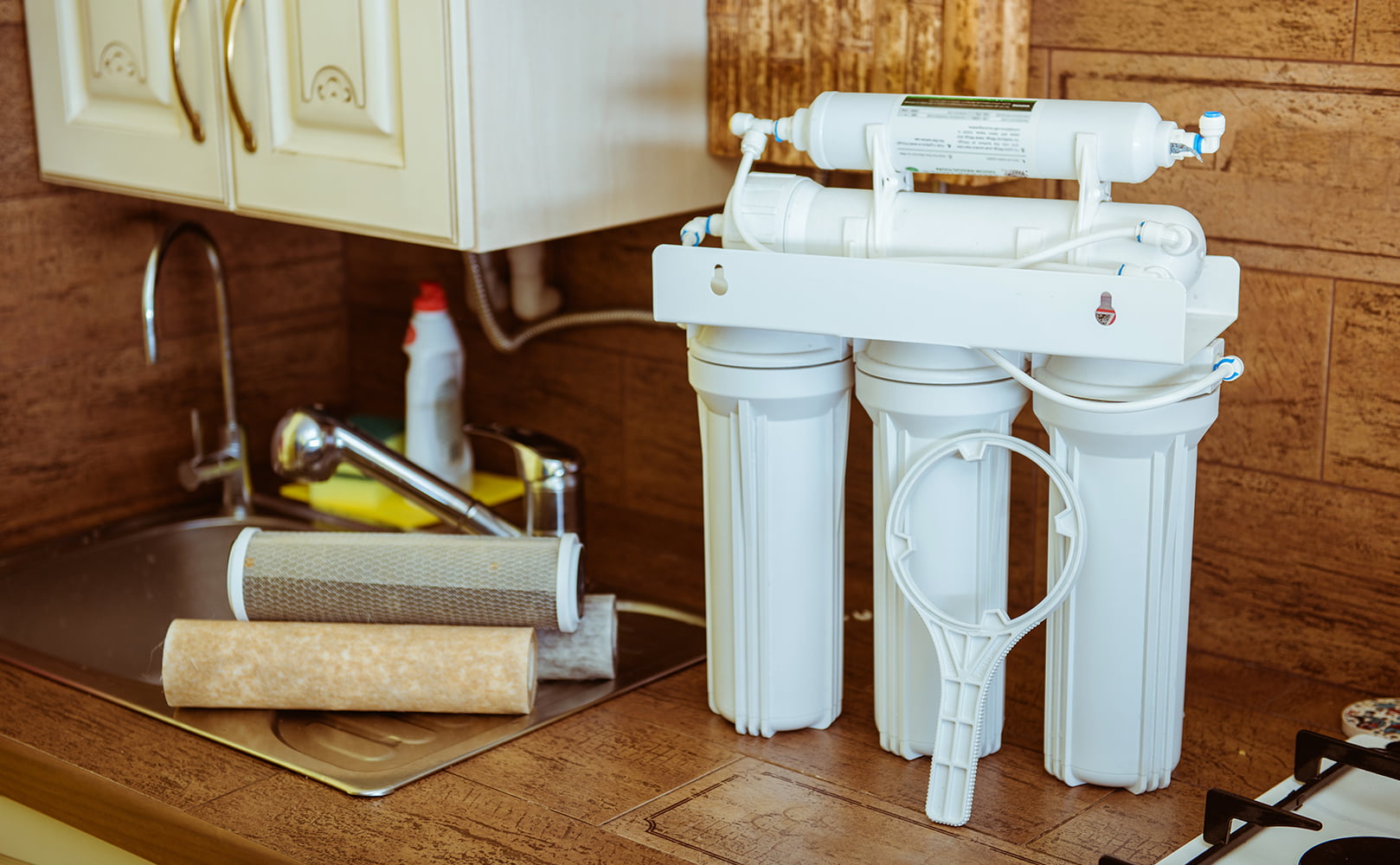Under Sink Water Filters vs Reverse Osmosis Systems
Written by: Gene Fitzgerald // Last Updated: Jan 4, 2023
This page may contain affiliate links. If you buy a product or service through such a link we earn a commission at no extra cost to you. Learn more.
Choosing the right water filtration system for your home is not as easy as it seems at first.
With multiple options available on the market, it can often take a good while until you’ve found a solution that works best for you.
Under sink water filters and reverse osmosis systems are among the most popular approaches on the market.
So, under sink water filters vs reverse osmosis systems – which one is better for your needs?
Key Takeaways
- There is not that big of a difference between under sink water filters and reverse osmosis systems.
- Under sink water filters can use a single or multiple filter stages, whereas RO systems always use pre and post-filtration in addition to the reverse osmosis membrane.
- Generally speaking, a reverse osmosis system is more powerful when it comes to overall contaminant reduction, but it also comes at higher cost. Tip: Have your water tested to identify the contaminants present. Base your buying decision on the results.
Under Sink Water Filters
An under sink water filter is a general single or multi-stage filtration system that’s specifically designed to be tucked away beneath your (kitchen) sink, hooking up to your plumbing at a point before water is dispensed from the faucet.
Under sink water filters are great for optimizing your home’s layout as they don’t get in the way and are relatively inexpensive.
How Under Sink Water Filters Work
Under sink water filters are attached to a cold water line, filtering the water before it reaches the faucet. This makes them simple and convenient, providing you with almost immediate access to filtered water on demand.
Many people prefer under sink water filters due to their smaller design and fast operation. They are also less expensive than whole house water filters for example.
Contaminant Removal
The contaminant removal properties of an under sink water filter depend on the specific filtration system it utilizes. Some models are very simple, only running your water through a single filter element. Multi-stage models, in comparison, utilize multiple filtration stages to maximize their filtration efficiency.
As a result, the level of contaminant removal varies across the board, making it important to understand your specific water situation and identify models that target the specific contaminants you’re dealing with.
Advantages
Compact Design
The small, compact design of under sink water filters is one of the main drawing factors for most people. They can easily fit in the cabinet under your sink and don’t require any adjustments to your plumbing in almost all cases. In some rare instances, you may have to run your pipes slightly differently to accommodate the shape of the filter.
Low Price
Compared to reverse osmosis systems, regular under sink water filters are relatively inexpensive and widely available in different models and configurations. Shopping for an under sink water filter is noticeably easier.
Only Targets Contaminants
Unlike reverse osmosis systems, under sink water filters are designed to only target contaminants through the use of specific filters. All essential minerals such as calcium are left untouched. This makes them a good choice in households where the water has high mineral contents.
Disadvantages
Not as Thorough as Reverse Osmosis
If you want your filtration to be as thorough as possible, often your best bet is to go with an RO system.
Separate Filters Required for Individual Faucets in the House
Homes with multiple faucets and other access points need separate under sink filters for each one. It’s generally not possible to hook up one filter to multiple faucets, with some rare exceptions. The total price of multiple filters can get quite high.
Reverse Osmosis Systems
Reverse osmosis is a popular approach to water filtration that’s been in use for quite a while now. Reverse osmosis filters come in various shapes and sizes, and can be easily adapted to common plumbing connections and layouts.
How RO Systems Work
A reverse osmosis system is typically comprised of several stages, with the semipermeable reverse osmosis membrane being only one part of the whole process. Water is usually pre-filtered before it reaches the RO filter itself, and the system might also apply some post-filtration to really get everything out of the way.
At the reverse osmosis stage, water is forcefully pushed through the membrane with microscopic holes designed to not allow anything larger than a water molecule through. This leaves almost all contaminants on the input end of the membrane.
As mentioned, RO systems come in different forms. There are:
- Countertop reverse osmosis systems – these are the most affordable and easiest to install.
- Under sink reverse osmosis systems – these are one type of under sink water filter.
- Whole house reverse osmosis systems – provide purified water to the entire home.
Contaminant Removal
One of the best things about reverse osmosis systems is their consistent, thorough contaminant removal capabilities. If you live in an area with heavy contamination problems, an RO system is often your best bet if you want to make sure that your water is as clean as possible.
Advantages
Advanced Filtration
Reverse osmosis is one of the best filtration methods available on the consumer market right now. It’s thorough and efficient, and leaves almost nothing in the water other than H2O molecules. This makes it perfect for cases where the water supply contains a large number of different contaminants, which may make filtration with ordinary systems expensive and prone to failure.
Available in Different Configurations
A reverse osmosis system can be adapted to many different configurations, depending on the user’s needs. No matter what shape you want your filtration device to have, there will always be something suitable on the market.
Disadvantages
More Expensive
On average, a reverse osmosis system will cost you more than other filtration methods, including a multi-stage under sink water filter. You should approach this purchase with a more flexible budget, otherwise it may be better to invest your money in an under sink filter.
Removes More Than Just Contaminants
One of the biggest disadvantages to reverse osmosis is that it’s not selective in what it removes from the water – it targets everything that can’t pass through the membrane. This means that it can also remove some beneficial elements – see below.
Slow
RO water treatment is very slow. That’s why under sink units come with their own storage tank.
Many Different Components
A reverse osmosis system is comprised of several different components such as a check valve and an ASO. This means that it’s more prone to issues compared to a simpler under sink filtration system.
Is RO Water Bad for You?
If your home has a water supply that’s rich in minerals, using a reverse osmosis system might actually reduce the quality of your drinking water. That’s because the filter will remove many useful nutrients along with regular contaminants. Make sure to check reports about your current water quality to figure out if RO water purification is the right approach for you.
What Are the Similarities and Differences Between Under Sink Water Filters and Reverse Osmosis Systems?
The main difference between under sink water filters and reverse osmosis systems is the filtration method. While it’s possible for reverse osmosis systems to be packaged as under sink models, standard under sink filters on the market utilize more basic filtration methods like activated carbon.
Other than that, both systems have the same general idea – they hook up to your plumbing, filtering water that passes through them before it reaches an access point like a faucet.
What to Consider When Choosing
When choosing between an under sink water filter and a reverse osmosis filter, your main consideration should be filtration strength. Do you want thorough filtration that covers most types of contaminants that may be found in your water supply, or do you only care about a select few?
You should also consider how much space you have available in your home. Smaller households can benefit from a single-stage under sink water filter due to its more compact design. Reverse osmosis systems tend to be bulkier, but they also come in smaller versions.
You might have to compromise some level of filtration quality if you want to use a smaller model, however. You should ideally consult an expert who can guide you through the purchasing process if you want to find a good balance between filtration quality and physical size.
If you have any thoughts about under sink water filters vs reverse osmosis systems please don’t hesitate to leave a comment below!
Information provided on BOS is for educational purposes only. The products and services we review may not be right for your individual circumstances.
We adhere to strict editorial guidelines. Rest assured, the opinions expressed have not been provided, reviewed, or otherwise endorsed by our partners – they are unbiased, independent, and the author’s alone. We fact-check all content for accuracy. It is accurate as of the date posted and to the best of our knowledge.




